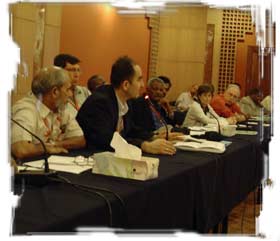El Batán, Mexico
November 3, 2006
Source:
CIMMYT E-News, vol 3 no.
10, October 2006
 When
wheat scientists and policy makers convened in Alexandria, Egypt
earlier this month, one might have been forgiven for thinking
that a war was afoot. And it is. Scientists are launching an
offensive against wheat stem rust, an old foe of farmers that is
threatening resurgence. When
wheat scientists and policy makers convened in Alexandria, Egypt
earlier this month, one might have been forgiven for thinking
that a war was afoot. And it is. Scientists are launching an
offensive against wheat stem rust, an old foe of farmers that is
threatening resurgence.
Words like ‘emergency’, ‘disaster’, ‘catastrophe’, and
‘devastation’, were used at the meeting to paint a picture of
the havoc that epidemics of the fungal disease, also known as
black rust, could precipitate on the world’s food security and
economy. “This is a global threat...,”
CIMMYT Director General Masa
Iwanaga told the First International Workshop of the
Global Rust Initiative
(GRI), 9-11 October. “The risk of a stem rust epidemic in wheat
in Africa, Asia and the Americas is real, and must be averted
before untold damage and human suffering is caused,” said
Mahmoud Solh, Director General of the
International Center for
Agricultural Research in the Dry Areas (ICARDA). Preliminary
field evidence from Kenya indicated that many more varieties of
wheat could be threatened by rust than previously thought.
The GRI—a consortium coordinated by CIMMYT and ICARDA that
involves agricultural research institutes from 30-plus
countries—will use scientific knowledge and global cooperation
as its primary ammunition to fight the disease. Tactics will
include worldwide surveillance for virulent strains of the stem
rust fungus Puccinia graminis (‘trap nurseries’—small fields
where wheat known to be susceptible to the new disease has been
planted) have been positioned in at-risk countries in Africa,
the Middle East and South Asia); zeroing in on resistance genes
and using these in breeding programs; and accelerated seed
multiplication and dissemination of the new, resistant breeds.
“We basically have to replace all the wheat in the world,” says
GRI Coordinator, CIMMYT wheat scientist Rick Ward.
It is no mean task; farmers and breeders select wheat varieties
for their high yield, robustness against pests and diseases, but
also properties such as grain color, maturity period, and bread
making quality, and the GRI’s work will have to keep these in
mind. Furthermore, preferences vary by region, often depending
on the form in which the wheat arrives at the table. Seed
delivery will also need to be addressed.
Infection with the fungal disease first appears as deep orange
pustules on young wheat stems, and without prompt intervention
with fungicides, farmers’ fields are converted into a tangled
mass of black stems with shriveled grain. Severe infections can
lead to total crop failure. A new variant of the fungus, Ug99,
has established itself in bread wheat farmers’ fields in Kenya
and Ethiopia, and resource-poor smallholders who cannot afford
fungicides are quickly losing the battle against stem rust.
Until new, resistant varieties are in the hands of farmers, Ward
says part of the GRI’s resources will be directed towards an
aggressive regimen of fungicides to suppress stem rust hot spots
before they spread. “A stem rust epidemic is much like a bush
fire; if it’s not contained, it becomes exceedingly difficult to
stop,” he says.
Researchers at the Alexandria meeting were relieved to hear that
GRI-coordinated screening of twelve thousand wheat cultivars has
yielded a handful of potential Ug99-resistant candidates. This
positive news came from researchers at Njoro, a high-altitude
research station of the Kenya
Agricultural Research Institute (KARI), and the Melkasa
station of the
Ethiopian Institute of Agricultural Research (EIAR). The
promising varieties are being fast-tracked for multiplication
and release to farmers. Ward announced that the GRI will now use
molecular breeding, which reduces the breeding process by
several years, as a routine.
Even with modern breeding and communication technologies, the
GRI’s success will hinge on the spirit of global cooperation to
overcome blights that threaten the world’s food security.
For more information contact
r.ward@cgiar.org
See also:
The World’s Wheat Crop is Under Threat from New Disease |